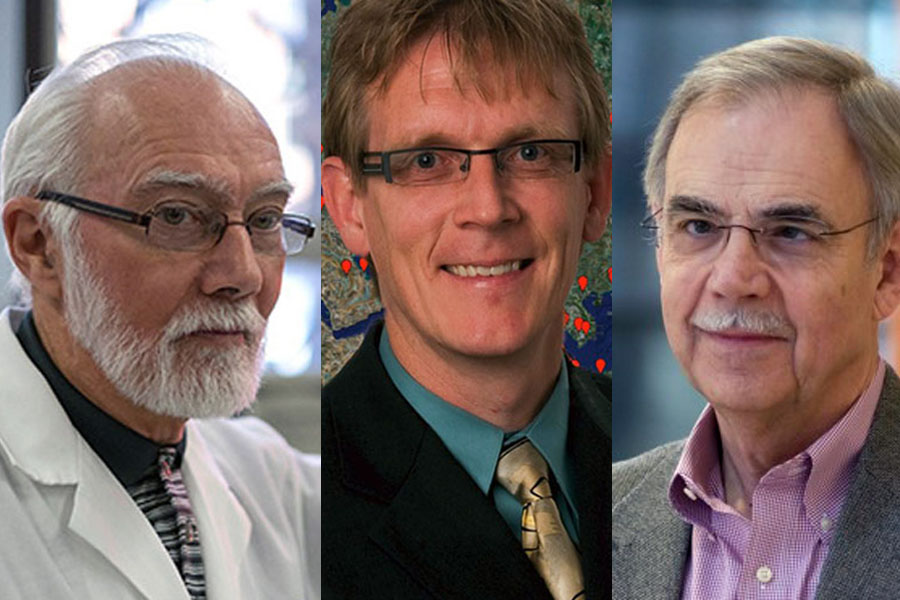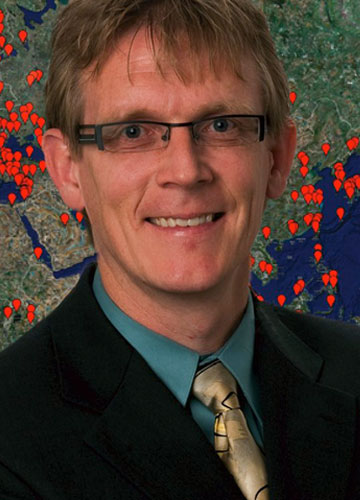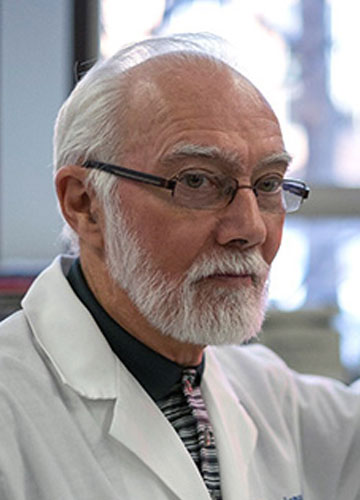J. Paul Robinson elected AAAS Fellow

The organization on Nov. 24 announced that the following faculty were elected as 2020 fellows: Gerhard Klimeck, professor of electrical and computer engineering; G.V. (Rex) Reklaitis, the Burton and Kathryn Gedge Distinguished Professor of Chemical Engineering; and J. Paul Robinson, professor in the Weldon School of Biomedical Engineering, director of the Purdue University Cytometry Laboratories, and the SVM Professor of Cytomics in the College of Veterinary Medicine.
Election as an AAAS fellow is a lifetime honor bestowed upon AAAS members by their peers. This year, 489 members have been awarded this distinction and will be formally announced Nov. 27 in the AAAS News & Notes section of the journal Science. An induction ceremony for new fellows will be held on Feb. 13, 2021.
Klimeck joined Purdue in 2003 and is the director of the Network for Computational Nanotechnology, which operates nanoHUB, the world’s premier online resource for nanoelectronics offering electronic device simulations and educational resources. He established nanoHUB’s architecture and analytics cyberinfrastructure and drove its expansion from 500 to more than 2 million users. Klimeck also developed simulation applications that have served more than 205,000 users in 172 countries. These applications are a new type of publication listed in Web of Science and Google Scholar.
Reklaitis came to Purdue in 1970 and has held a large variety of positions, including head of the School of Chemical Engineering, assistant dean of engineering for Graduate Education and Research, director of the Computer Integrated Process Operations Center (CIPAC), and deputy director of the NSF Engineering Research Center on Structured Organic Particulate Systems. He was selected as a fellow for leading contributions to process systems engineering - including batch processing, supply chain and enterprise-wide optimization and pharmaceutical manufacturing - and for achievements in education and service.
Robinson’s AAAS selection was based on his distinguished contributions to the field of advanced cytometric analysis and expanding cellular and microbial detection technologies. He was an early adopter of web-based educational materials by publishing one of the first-known published CDROMs in 1996 and has since published 14 CD-ROMS or DVDs with a total distribution of around 100,000 copies – all distributed free of charge. His research area has been focused on reactive oxygen species primarily in neutrophils and cell lines. His lab is currently focused on mitochondrial function, and he also is engaged in developing translational tools for better diagnostics for cervical cancer.
AAAS fellows are selected through a 3-Fellow nomination process, which requires a group of three previously-elected AAAS Fellows to serve as sponsors to nominate another AAAS member. Nominations are considered for AAAS members whose efforts on behalf of the advancement of science or its applications are scientifically or socially distinguished.
More about Gerhard Klimeck:

His election as an AAAS fellow recognizes his achievements in developing some of the most realistic simulations of ultra-small transistors. His research played a major role in establishing the NEGF (non-equilibrium Green’s function) formalism as the method of choice to model electron flow at the nanometer scale and the tight-binding method as the preferred atomistic basis set. The widespread use of NEGF in research and advanced technology development that we see today owes much to the vision of Klimeck and his 25-year effort to bring this vision to fruition.
Klimeck also invented the NEMO software tool suite, which sets the modeling standard for today’s industrial nano-scale devices. His tools and model approaches are now used in industry to design transistors. His NEMO tool alone powers nine different nanoHUB applications used by more than 30,000 users who have done over 600,000 simulations. More than 300 publications and over 4,000 students using the software in nearly 400 classes illustrate the broad impact of these NEMO-based nanoHUB tools.
He is a fellow of the following organizations: Institute of Physics (elected in 2011); American Physical Society (elected in 2011); and Institute of Electrical and Electronic Engineers (elected in 2012). He is a research prize winner and member of Alexander von Humboldt Foundation, Germany (2019).
In October 2020, nanoHUB was honored with the R &D World Magazine’s R&D 100 Award. This prestigious award was established in 1963 and recognizes the most revolutionary technologies introduced to the market over the past year.
Klimeck’s prior positions included Texas Instruments and the NASA Jet Propulsion Laboratory at California Institute of Technology. Klimeck has been granted five U.S. patents with two additional patents pending and disclosed.
He earned his Diploma in Electrical Engineering, with highest distinction, from Ruhr University, Bochum, Germany, in 1990, and in 1994, he received his PhD in electrical engineering from Purdue University.
More about G.V. (Rex) Reklaitis:

His research involves the application of computing and information and systems technology to support the complex decisions inherent to the design and operation of processing systems. Recent areas of emphasis include investigation of approaches to support batch and semi-continuous operations as well as methodology for plant- and enterprise-wide planning and optimization with applications in the pharmaceutical industry and in integrated energy systems.
Reklaitis was elected a member of the National Academy of Engineering in 2007 and has been a member of the Editorial Advisory Board for the Journal of Pharmaceutical Innovation since 2006. He served as editor-in-chief (1986-2008) and won the Best Paper of 2006, both with Computers & Chemical Engineering.
In addition to AAAS, he is a member of the U.S. National Academy of Engineering (NAE), American Institute of Chemical Engineers (AIChE – director 1997-1999), American Chemical Society (ACS), American Society for Engineering Education (ASEE), and Institute for Operations Research and the Management Science (INFORMS).
He is the recipient of several awards, including the John M. Prausnitz AIChE Institute Lecturer Award and the AIChE Warren K. Lewis Award for Chemical Engineering Education, both in 2017. In addition, he was named the winner of the Council for Chemical Research Pruitt Award in 2015 and the European Federation of Chemical Engineering Long Term Achievement Award in Computer Aided Process Engineering in 2013.
He earned his BS with highest distinction in chemical engineering from Illinois Institute of Technology in 1965, and his MS and PhD in chemical engineering from Stanford University in 1969.
More about J. Paul Robinson:

His background is in immunopathology, and he has had a long-term interest in the evaluation of phenotypic analysis of blood cells. He and his team have developed several cell analysis technologies for functional analysis of white blood cells using flow cytometry and various imaging modalities. His lab has significant experience in evaluating phenotypic status of blood samples, particularly the dissection of T cell, B cell and a variety of other cellular subsets. He also has much experience in sorting cell populations for future cell culturing needs or for additional molecular genetic analysis.
His research team over the last several years has expanded its interest in bioengineering with hardware and software groups developing innovative technologies such as: hyperspectral cytometry using multiarray PMTs (currently commercialized by Sony); optical tools for quantitative fluorescence measurement; advanced classification approaches for clinical diagnostics and bacterial classification; and high content, high throughput screening technologies to evaluate drug toxicity.
Robinson is the past president of the International Society for Advancement of Cytometry, editor-in-chief of Current Protocols in Cytometry, associate editor of Histochemica et Cytobiologica, and associate editor of Cytometry Part A.
He was elected to the College of Fellows, American Institute for Medical & Biological Engineering (AIMBE) in 2004, received the Pfizer Award for Innovative Research in 2004, and the Gamma Sigma Delta Award of Merit Research in 2002.
He earned his PhD in immunopathology from the University of New South Wales, Sydney, Australia and completed a postdoctoral fellowship at the University of Michigan.
About AAAS
According to its website, the organization seeks to “advance science, engineering and innovation throughout the world for the benefit of all people” through initiatives in science policy, international programs, science education and public engagement. The organization was formed in 1848, marking the emergence of a national scientific community in the United States.
The nonprofit AAAS is the world’s largest general scientific society and publisher of Science, as well as other scientific journals. The organization includes more than 250 affiliated societies and academies of science, serving 10 million individuals.
Klimeck, Reklaitis and Robinson are the ninth, 10th and 11th current College of Engineering faculty members to be named fellows. They join the following colleagues: Michael Ladisch (ABE); Mark Lundstrom and Muhammad Alam (ECE); Matthew Ohland and Audeen Fentiman (ENE); Srinivasan Chandrasekar (IE); David Bahr and Haiyan Wang (MSE); and Ahmed Hassanein (NE).
http://www.cyto.purdue.edu/archive/flowcyt/staffpgs/jpr-bio-photo-jan-2007-1.pdf
https://engineering.purdue.edu/ChE/people/ptProfile?resource_id=11228#research-interests-page
